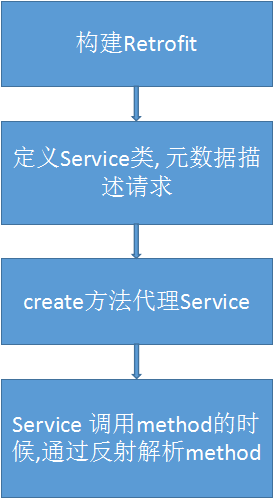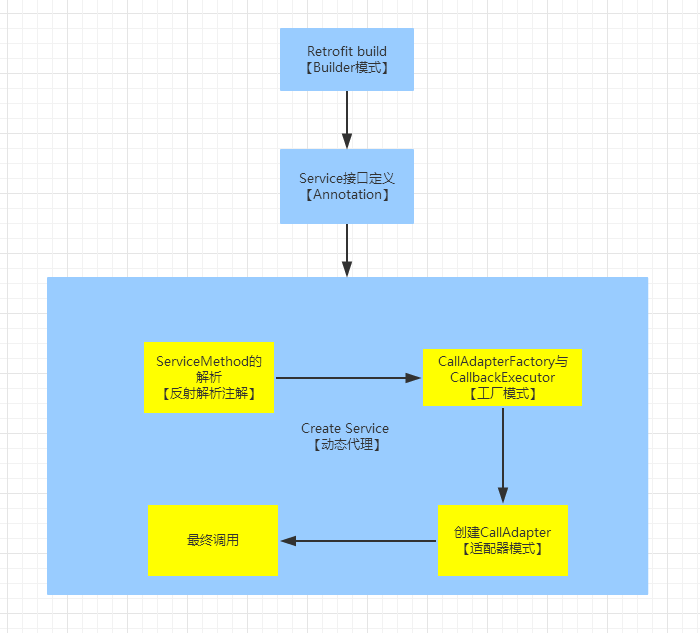Retrofit 2 源码分析
惯例从一个例子入手
//使用Builder模式创建Retrofit对象
Retrofit retrofit = new Retrofit.Builder()
.baseUrl("https://api.github.com/")
.addConverterFactory(GsonConverterFactory.create())
.build();
//创建Service对象, 这里统称为Service, 其实是一个接口的描述
GitHubService service = retrofit.create(GitHubService.class);
//发起请求调用
Call<List<Repo>> repos = service.listRepos("octocat");
定义Service接口
其实就是用元数据很清晰的描述一个HTTP请求以及参数等等
public interface GitHubService {
@GET("users/{user}/repos")
Call<List<Repo>> listRepos(@Path("user") String user);
}
使用Builder模式创建Retrofit对象
这里有两个点比较有趣, 为一些属性做了default处理, 一个是保护性拷贝
public static final class Builder {
private final Platform platform;
private okhttp3.Call.Factory callFactory;
private HttpUrl baseUrl;
private final List<Converter.Factory> converterFactories = new ArrayList<>();
private final List<CallAdapter.Factory> adapterFactories = new ArrayList<>();
private Executor callbackExecutor;
private boolean validateEagerly;
...
public Retrofit build() {
if (baseUrl == null) {
throw new IllegalStateException("Base URL required.");
}
okhttp3.Call.Factory callFactory = this.callFactory;
if (callFactory == null) {
callFactory = new OkHttpClient();
}
Executor callbackExecutor = this.callbackExecutor;
if (callbackExecutor == null) {
callbackExecutor = platform.defaultCallbackExecutor();
}
//注意看这里, 这里用了个保护性拷贝创建两个list 比较有趣。
// Make a defensive copy of the adapters and add the default Call adapter.
List<CallAdapter.Factory> adapterFactories = new ArrayList<>(this.adapterFactories);
//这里后续会看到他添加了默认的CallAdapterFactory
adapterFactories.add(platform.defaultCallAdapterFactory(callbackExecutor));
// Make a defensive copy of the converters.
List<Converter.Factory> converterFactories = new ArrayList<>(this.converterFactories);
return new Retrofit(callFactory, baseUrl, converterFactories, adapterFactories,
callbackExecutor, validateEagerly);
}
创建Service的对象, 动态代理模式
如果说前面的GitHub 接口是对一个请求的描述, 那么create方法就是要生成这个被描述请求的对象。
通过create 方法, 动态代理GitHub这个接口, 解析Annotation, 生成调用对象等
public <T> T create(final Class<T> service) {
//验证service 是interface 并且, 不能继承其他接口
Utils.validateServiceInterface(service);
//是否急切的先执行loadServiceMethod
if (validateEagerly) {
eagerlyValidateMethods(service);
}
return (T) Proxy.newProxyInstance(service.getClassLoader(), new Class<?>[] { service },
new InvocationHandler() {
private final Platform platform = Platform.get();
@Override public Object invoke(Object proxy, Method method, Object... args)
throws Throwable {
// 如果调用者的class对象是Object, 则执行默认的method 调用
if (method.getDeclaringClass() == Object.class) {
return method.invoke(this, args);
}
if (platform.isDefaultMethod(method)) {
return platform.invokeDefaultMethod(method, service, proxy, args);
}
//这里可以认为是解析调用方法参数等, 生成serviceMethod对象
ServiceMethod<Object, Object> serviceMethod =
(ServiceMethod<Object, Object>) loadServiceMethod(method);
//根据serviceMethod 最终实例化OkHttpCall 对象
OkHttpCall<Object> okHttpCall = new OkHttpCall<>(serviceMethod, args);
//调用callAdaper去生成Call对象, 这里传入的是okHttpCall, 最后会用到
return serviceMethod.callAdapter.adapt(okHttpCall);
}
});
}
缓存ServiceMethod, 假设这个Service(比如Github)被解析过了会缓存起来
看看这个loadServiceMethod, 首先检查serviceMethodCache, 这个cache是个ConcurrentHashMap,
如果缓存不存在, 则利用 ServiceMethod.Builder生成一个ServiceMethod
ServiceMethod<?, ?> loadServiceMethod(Method method) {
ServiceMethod<?, ?> result = serviceMethodCache.get(method);
if (result != null) return result;
synchronized (serviceMethodCache) {
result = serviceMethodCache.get(method);
if (result == null) {
result = new ServiceMethod.Builder<>(this, method).build();
serviceMethodCache.put(method, result);
}
}
return result;
}
总结上面的流程:
 image_1b3u27ohat9u1dfku2ub9crgt9.png-20kB
image_1b3u27ohat9u1dfku2ub9crgt9.png-20kB
ServiceMethod 是怎么解析Method
首先通过SeviceMethod.Builder 构建ServiceMethod
Builder(Retrofit retrofit, Method method) {
this.retrofit = retrofit;
this.method = method;
//这里利用反射的方法获取方法的Annotation, 参数类型, 参数的Annotation
this.methodAnnotations = method.getAnnotations();
this.parameterTypes = method.getGenericParameterTypes();
this.parameterAnnotationsArray = method.getParameterAnnotations();
}
public ServiceMethod build() {
//创建CallAdatper
callAdapter = createCallAdapter();
responseType = callAdapter.responseType();
if (responseType == Response.class || responseType == okhttp3.Response.class) {
throw methodError("'"
+ Utils.getRawType(responseType).getName()
+ "' is not a valid response body type. Did you mean ResponseBody?");
}
//创建Response数据处理器
responseConverter = createResponseConverter();
...
创建CallAdapter, 首先通过反射获取method返回的类型
private CallAdapter<T, R> createCallAdapter() {
Type returnType = method.getGenericReturnType();
if (Utils.hasUnresolvableType(returnType)) {
throw methodError(
"Method return type must not include a type variable or wildcard: %s", returnType);
}
if (returnType == void.class) {
throw methodError("Service methods cannot return void.");
}
Annotation[] annotations = method.getAnnotations();
try {
//noinspection unchecked
return (CallAdapter<T, R>) retrofit.callAdapter(returnType, annotations);
} catch (RuntimeException e) { // Wide exception range because factories are user code.
throw methodError(e, "Unable to create call adapter for %s", returnType);
}
}
retrofit.callAdapter其实是遍历adapterFactories,调用adapterFactor.get()创建CallAdapter
public CallAdapter<?, ?> nextCallAdapter(CallAdapter.Factory skipPast, Type returnType,
Annotation[] annotations) {
checkNotNull(returnType, "returnType == null");
checkNotNull(annotations, "annotations == null");
int start = adapterFactories.indexOf(skipPast) + 1;
for (int i = start, count = adapterFactories.size(); i < count; i++) {
CallAdapter<?, ?> adapter = adapterFactories.get(i).get(returnType, annotations, this);
if (adapter != null) {
return adapter;
}
}
默认的CallAdapterFactory与CallbackExecutor
如果最开始初始化Retrofit时没有传adapterFactories, 则使用默认的CallAdapterFactory 和默认CallbackExecutor , 从下面代码可以看出, 默认的CallbackExecutor 是在主线程执行。
static class Android extends Platform {
@Override public Executor defaultCallbackExecutor() {
return new MainThreadExecutor();
}
@Override CallAdapter.Factory defaultCallAdapterFactory(Executor callbackExecutor) {
return new ExecutorCallAdapterFactory(callbackExecutor);
}
static class MainThreadExecutor implements Executor {
private final Handler handler = new Handler(Looper.getMainLooper());
@Override public void execute(Runnable r) {
handler.post(r);
}
}
}
创建CallAdapter
CallAdapter是由CallAdapterFactory生产的
再来看下默认的CallAdapterFactory的实现
get方法, 生成一个实现了CallAdapter接口的对象
然后adapt又生成了Call对象
简单点说就是CallAdapterFactory(制造CallAdapter对象)创建一个CallAdapter(适配Call的对象),传入callbackExecutor(怎么去执行, 比如在主线程执行), Factory 你可以自定义, CallAdapter也可以自定义, Executor也可以自定义, 非常灵活
@Override
public CallAdapter<?, ?> get(Type returnType, Annotation[] annotations, Retrofit retrofit) {
if (getRawType(returnType) != Call.class) {
return null;
}
final Type responseType = Utils.getCallResponseType(returnType);
return new CallAdapter<Object, Call<?>>() {
@Override public Type responseType() {
return responseType;
}
//调用adapt 方法, 实例化Call对象, 传入callbackExecutor
@Override public Call<Object> adapt(Call<Object> call) {
return new ExecutorCallbackCall<>(callbackExecutor, call);
}
};
}
CallAdapter 适配器模式
CallAdapter是一个接口,他定义了
//response body 转换为 java 对象时使用, 告诉Converter 转为什么类型
Type responseType();
//如何生成call
T adapt(Call<R> call);
Call也是个接口
//异步调用
void enqueue(Callback<T> callback);
boolean isExecuted();
//取消调用
void cancel();
boolean isCanceled();
//原始的http请求
Request request();
再来看下默认的Call实现:
static final class ExecutorCallbackCall<T> implements Call<T> {
final Executor callbackExecutor;
final Call<T> delegate;
ExecutorCallbackCall(Executor callbackExecutor, Call<T> delegate) {
this.callbackExecutor = callbackExecutor;
this.delegate = delegate;
}
@Override public void enqueue(final Callback<T> callback) {
if (callback == null) throw new NullPointerException("callback == null");
//调用委托来异步请求, 这个委托就是就是最上面讲到的传入的OkhttpCall对象
delegate.enqueue(new Callback<T>() {
@Override public void onResponse(Call<T> call, final Response<T> response) {
//这里的callbackExecutor 就是开始看到的默认的callbackExecutor
//解释下, 当请求完成后, 调用callbackExecutor来执行逻辑
//这里callbackExecutor 上面说过到的默认Execute, 即在主线程的handler里面处理响应结果
callbackExecutor.execute(new Runnable() {
@Override public void run() {
if (delegate.isCanceled()) {
// Emulate OkHttp's behavior of throwing/delivering an IOException on cancellation.
callback.onFailure(ExecutorCallbackCall.this, new IOException("Canceled"));
} else {
callback.onResponse(ExecutorCallbackCall.this, response);
}
}
});
}
@Override public void onFailure(Call<T> call, final Throwable t) {
callbackExecutor.execute(new Runnable() {
@Override public void run() {
callback.onFailure(ExecutorCallbackCall.this, t);
}
});
}
});
}
}
所以说, 你可以自己实现一个CallApdater来实现处理调用的逻辑, 以及调用之后处理结果的逻辑
很简单, 看下默认的ExecutorCallAdapterFactory 的实现就明白了
首先
final class ExecutorCallAdapterFactory extends CallAdapter.Factory
然后 重写get方法
@Override
public CallAdapter<?, ?> get(Type returnType, Annotation[] annotations, Retrofit retrofit) {
if (getRawType(returnType) != Call.class) {
return null;
}
final Type responseType = Utils.getCallResponseType(returnType);
return new CallAdapter<Object, Call<?>>() {
@Override public Type responseType() {
return responseType;
}
@Override public Call<Object> adapt(Call<Object> call) {
return new ExecutorCallbackCall<>(callbackExecutor, call);
}
};
}
static final class ExecutorCallbackCall<T> implements Call<T> {
adapt里面 实例化一个Call 对象, Call对象的实现如下
实现Call<T>接口, 重写enqueue方法, 剩下的想怎么玩就怎么玩
static final class ExecutorCallbackCall<T> implements Call<T>
@Override public void enqueue(final Callback<T> callback) {
整个流程基本上已经剖析完成, 总结下
 image_1b410r131p0q13t51mr812cjb4113.png-33.8kB
image_1b410r131p0q13t51mr812cjb4113.png-33.8kB
一些有趣的小点:
比如使用unmodifiableList 做保护性copy, 说白了就是让他list不可变
this.converterFactories = unmodifiableList(converterFactories); // Defensive copy at call site.
this.adapterFactories = unmodifiableList(adapterFactories); // Defensive copy at call site.
涉及到的反射API:
method.getDeclaringClass() //获取该方法调用者的class对象
method.getAnnotations() //获取该方法所有的Annotation
method.getDeclaringClass() //获取该方法调用者的class对象
method.getGenericParameterTypes(); //获取参数类型
method.getParameterAnnotations(); //或者参数的Annotation













网友评论